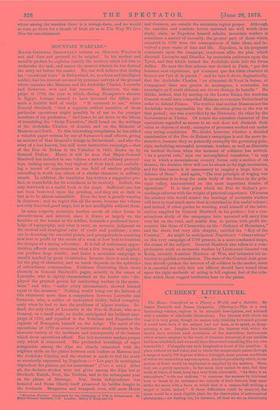CURRENT LITERATURE.
The Moon: Considered as a Planet, a World, and a Satellite. By Nasmyth and James Carpenter. (Murray.)—This is a very fascinating volume, copious in its scientific descriptions, and adorned with a number of admirable illustrations. The interest with which we read it is very great, though we cannot help thinking how much greater it would have been if the subject had not been, so to speak, so disap- pointing a one. Imagine how breathless the interest with which we should have awaited each revelation of the marvellous instruments which science employs in the work of lunarian discovery, if our satellite had been inhabited, and we could have discovered something like our own human life I Unhappily any such imagination is out of the question. A place without air and water, and in which the temperature passes through a range of nearly 700 degrees within a fortnight, must present conditions of which we cannot form any conception. Another peculiarity which, to our notions at least, would be unpleasant is supplied by the meteors. Here, they are a pretty spectacle ; in the moon they cannot be seen, but they must, at times, at least, keep up a very brisk cannonade. "As there is no atmosphere," write our authors, "to consume the meteors by frictional heat or break by its resistance the velocity of their descent, they must strike the moon with a force to which that of a cannon-ball striking a target is feeble indeed." If these difficulties could be removed, the moon would be a most eligible place for the observation of astronomical phenomena,—for finding out, for instance, all that we are so laboriously
seeking to discover about the sun. The earth, too, would present a spectacle of extraordinary beauty :— " At this aunset time, the earth, nearly in the zenith of us [the supposed lunar spectators], will be at its half-illuminated phase, and even then it will shed more light than we receive upon the brightest of moonlight nights. As the night proceeds, the earth's phase
w ill increase through the gibbous stages until at midnight it will Its 'full,' and our orb will be seen in its entire beauty. It will perform at least one of its twenty-four-hourly rotations during the time that it appears quite full [the night is more than three hundred hours long], and the whole of its surface features will in that time pass before the lunar spectator's eye. At times the northern pole will bo turned towards our view, at times the southern ; and its polar ice-caps will appear as bright, white spots marking its axis of rotation. The seas would appear (as far as can be inferred) of pale blue-green tint, the continents parti-coloured, and the tinted spots would vary with the changing terrestrial seasons."



































 Previous page
Previous page